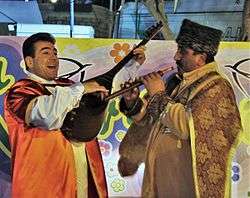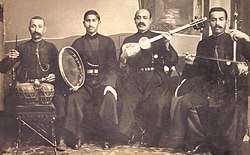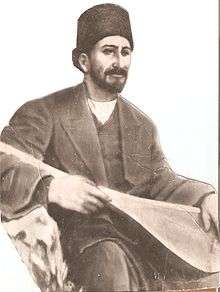Ashiqs of Azerbaijan
The art of Azerbaijani Ashiqs combines poetry, storytelling, dance and vocal and instrumental music into a traditional performance art. This art is one of the symbols of Azerbaijani culture and considered an emblem of national identity and the guardian of Azerbaijani language, literature and music.
| Art of Azerbaijani Ashiq | |
|---|---|
 Azerbaijani ashiqs in Nowruz | |
| Country | Azerbaijan |
| Reference | 253 |
| Region | Europe and North America |
| Inscription history | |
| Inscription | 2008 (4th session) |
| Music of Azerbaijan | |
|---|---|
 | |
| General topics | |
| Genres | |
| Specific forms | |
| Traditional music | |
| Subgenres | |
| Media and performance | |
| Music festivals | |
| Music media | Medeniyyet TV |
| Nationalistic and patriotic songs | |
| National anthem | March of Azerbaijan |
| Azerbaijani Ashiq music | |
|---|---|
| Stylistic origins | World music |
| Cultural origins | ca. 15th – 16th century |
| Typical instruments | Azerbaijani saz |
| Subgenres | |
| Qoshma, Muhammas, Ustadname, Gifilband | |
| Regional scenes | |
| Ozan music | |
Characterized by the accompaniment of the kopuz, a stringed musical instrument, the classical repertoire of Azerbaijani Ashiqs includes 200 songs, 150 literary-musical compositions known as dastans, nearly 2,000 poems and numerous stories.
Since 2009 the art of Azerbaijani Ashiqs has been inscribed on the Representative List of the Intangible Cultural Heritage of Humanity.
Etymology
In today's encyclopedic dictionaries the word Ashiq, which means "one who is in love", is derived from the Arabic and Persian. Some encyclopedias define Ashiq as a folk singer-poet of Caucasus and neighboring nations. In addition to songs of his own, in repertory Ashiq includes epic tales and folk songs.[1]
History
Early origins
The earliest traces of art of Azerbaijani ashiqs can be found in the 7th century Book of Dede Korkut, which contains the most famous epic stories of the Oghuz Turks.[2][3]
From the 16th century, Azerbaijani ashiqs have been the bearers and guardians of the national language, national identity and the music performed in weddings, parties and folk festivals.[4] During the 20th century, ashiq performances on concert stages, the radio and television became common.
Soviet period (1930–1991)
Beginning in the 1930s, the Art of Azerbaijani ashiqs, like all folk music culture of the peoples of the USSR fell under the strictest control of the state government.[5][6] As Soviet Union highly appreciated the art, during the Cultural Revolution the ashiq art, along with the mugham art of Azerbaijan has been developed while meykhana faced with certain restrictions. In 1938, the first congress of Azerbaijani ashiqs have been held and the large collection of ashiq poetry have been published. Monuments have been made for the ashiqs, their works added to school books and their anniversaries have been celebrated not only in Azerbaijan SSR but also in neighboring Georgian SSR and Armenian SSR, where Ashig Alasgar was born.
Modern history and worldwide acceptance (1991–present)

In modern Azerbaijan, professional Ashiqs were divided into two categories: Ashiq-performers and Ashiq-poets. Ashiq-performers, despite being professional storytellers, are not engaged in poetry. Due to their individual abilities and a keen understanding of the specifics of the native folklore, they make different kinds of variations and changes in their epics and legends, especially in their prose.[7]
Ashiq-poets, on the contrary, along with storytelling activities, engaged also in poetry. In Azerbaijan, such Ashiqs were called Ustad, which translates from Persian as a "master". Ashiq-poets have their own schools, where they teach their students the basics of ashiq creativity. Famous Ashiq-poets include such gifted poets as Gurbani, ashiq Abbas from Tufargan, Xəstə Qasım (Hasta Gasym), ashiq Valeh, Ashig Alasgar and many others. They had a tremendous impact not only on ashig poetry, but also greatly influenced the written literature of Azerbaijan.[8]
The popular ashigs of modern Azerbaijan include ashiq Zulfiyya, ashiq Nemet Qasimli, ashiq Ahliman, ashiq Adalat, ashiq Kamandar, Ali Tovuzly and ashiq Khanlar.[7] The late Zalimkhan Yagub, member of parliament of Azerbaijan and Chairman of the Union of Ashiqs through 2015, was also very popular.
After Azerbaijan's independence from the USSR, Art of Azerbaijani ashiqs engaged in the worldwide promotion campaign of Culture of Azerbaijan. The art also received heavy state support, which organized tours for ashiqs around the world.
As of 2009, the total number of Azerbaijani Ashiqs in the world reached 3000 people, which included in UNESCO's Intangible Cultural Heritage list.[4][9]
Delivery
In Azerbaijan, ashigs' style of performance differ in the specific characteristics of local creativity. For example, each ashig representing the regions of Ganja, Kalbajar, Gazakh, Tovuz and Borchali markedly differ in their individual skill and cherish traditional ashig art.[10] Often performances of ashigs are accompanied by a balaban performer and an ensemble of wind instruments, but the main musical instrument of ashigs is considered to be Azerbaijani saz.[11] The creative abilities of ashigs differ to the following:
- Usta-Ashiqs. Poet of the people "Usta ashough (Ashiq-master) – writes the epics, poems, creating songs, sings and plays for the saz and their performance is accompanied by dance movements.
- Ashiq-instrumentalist. This role includes spreading the art of famous Ashiqs, singing and playing the saz, and sometimes dancing.
- Ashiq-narrators are sometimes performed solo, or are accompanied by the saz or the duduk player who, while dancing, moves next to him.
Genres of Azerbaijani Ashiq music
The main genres of Azerbaijani Ashiq poetry include goshma, dastan, ustadnameh, as well as their poetic forms — gerayli, divani, tajnis.[8]
Goshma
Goshma is the most common form of Ashiq folk poetry. The number of syllables in goshma can reach eleven. Goshma itself are also divided into several subgenres such as Gozallama — a form which describes the natural beauty and praises the remarkable properties of human speech, Kochaklama — the form in which the glorification of heroic deeds or the heroes occurs, Tashlama — genre which criticizes social or human vices, and Agyt — the memorial chant.[12]
Dastan
Dastan (Persian: داستان "story"[13][14]) is a genre, known not only in Eastern poetry, but also in Western poetry (including traditional folk poetry). In dastans, ashiqs narrates heroic deeds, love stories or important historical events. Stylistic and syllabic relationships are in many ways reminiscent of the goshma genre, but differ from the last number of quatrains, subject, meaning and theme music.[15][16]
Notable Performers
Individuals
Female
Male

- Ashiq Ahliman
- Ashig Alasgar
- Alqayıt
- Ashiq Aly
- Ashiq Asad
- Sari Ashiq
- Molla Juma
- Ashiq Qurbani
- Ashiq Islam
- Ashiq Kamandar
- Ashiq Musa
- Ashiq Qarib
- Khasta Qasim
- Ashiq Ali Tapdigogly
- Ashiq Pasha
- Ashiq Panah
- Ashiq Valeh
- Ashiq Abbas Tufarghanli
- Ashiq Yusuf Ohanes
References
- "АШУГ". ubrus.org. Retrieved 2 January 2011.
- Anar. "Mother-of-All-Books". Azerbaijan International Magazine. Archived from the original on 9 December 2010. Retrieved 2 January 2011.
- Peart, Ian. "Nemet Qasimli – A Bard in Baku". Retrieved 2 January 2011.
- "The Art of Azerbaijani Ashiq". tourism-review.com. Retrieved 2 January 2011.
- "Hamı əlinə saz götürüb çıxıb meydana..." Archived from the original on 6 July 2011. Retrieved 2 January 2011.
- "SOVET AZƏRBAYCANININ ÇİÇƏKLƏNƏN İNCƏSƏNƏTİ". Retrieved 2 January 2011.
- "MUSİQİ". Retrieved 2 January 2011.
- "The Ashig Folk Art". Ministry of Culture and Tourism of Azerbaijan. Archived from the original on 28 November 2010. Retrieved 2 January 2011.
- "The art of Azerbaijani Ashiq". List of the Intangible Cultural Heritage of Humanity. UNESCO. Retrieved 3 January 2011.
- "AZƏRBAYCAN MUSİQİSİ". Retrieved 2 January 2011.
- "Aşıq sənəti". Archived from the original on 4 June 2011. Retrieved 2 January 2011.
- "Формы ашугского творчества". REPUBLIC OF TURKEY MINISTRY OF CULTURE AND TOURISM. Retrieved 2 January 2011.
- Steingass, Francis Joseph. A Comprehensive Persian-English dictionary, including the Arabic words and phrases to be met with in Persian literature. London: Routledge & K. Paul, 1892.
- Russell, R., 1993. The Pursuit of Urdu Literature: A Select History. Palgrave Macmillan, Original from the University of Michigan. P. 85. ISBN 1-85649-029-7, ISBN 978-1-85649-029-0
- "Azərbaycan Aşıqlar Birliyinin sədri, aşıq-şair Qaracan İsa oğlu Kərimli (Borçalı)". Retrieved 2 January 2011.
- Mammadov, Tariyel. "DASTAN YARADICILIĞI". Archived from the original on 6 February 2011. Retrieved 2 January 2011.
- Qaliboghlu, Elchin. "Aşıq Ağaların poeziyası". Retrieved 2 January 2011.
